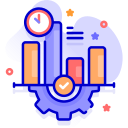Process Discovery: Finding High-Impact AI Opportunities
Instrument your processes with lightweight time tracking, system logs, and queue analytics. Data reveals hidden queues, context switching, and costly rework. Subscribe to get our worksheet that helps you baseline effort before introducing AI-driven improvements.
Process Discovery: Finding High-Impact AI Opportunities
Break tasks into categories: predict (forecast demand), generate (draft responses), decide (approve exceptions), retrieve (surface knowledge). Matching task type to AI strength avoids disappointment. Post a task example below, and we’ll help map it to a capability.
Process Discovery: Finding High-Impact AI Opportunities
Score candidates by potential impact and implementation effort. Start with low-effort, high-impact wins to build momentum and trust. Want our triage matrix template? Comment “matrix” and we’ll share a guided version tailored to efficiency outcomes.
Process Discovery: Finding High-Impact AI Opportunities
Lorem ipsum dolor sit amet, consectetur adipiscing elit. Ut elit tellus, luctus nec ullamcorper mattis, pulvinar dapibus leo.









